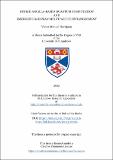Hybrid ancilla-based quantum computation and emergent Gaussian multipartite entanglement
Abstract
In the first half of this thesis, we present two models of ancilla-based quantum computation
(ABQC). Computation in the ABQC models is based on effecting changes on a register through
the interaction with and manipulation of an ancillary system. The two models presented enable
quantum computation through only unitary control of the ancilla – the ancilla-controlled model
(ACQC) – or supplemented by measurements on the ancilla which drive the register transfor-
mations – the ancilla-driven model (ADQC). For each of the models, we work on systems which
couple two continuous variables (CV) or which are hybrid: the register is formed by two-level
systems while the ancilla is a CV degree of freedom.
The initial models are presented using eigenstates of momentum as the ancillas. We move
to a more realistic scenario by modelling the ancillas as finitely squeezed states. We find that
the completely unitary ACQC contains persistent entanglement between register and ancilla in
the finite-squeezing scenario. In the ancilla-driven model, the effect of finite squeezing is to scale
the register state by a real exponential which is inversely proportional to the squeezing in the
ancilla.
In the second part, we cover work on Genuine Gaussian Multipartite Entanglement (Gaussian
GME). We present an algorithm for finding Gaussian states that have GME despite having
all two-state reductions separable. This touches on the idea of entanglement as an emergent
phenomenon. We determine GME via witnesses which probe only a subset of the state. We
therefore referred to them as partially blind witnesses. The algorithm is based on semi-definite
programs (SDPs). Such optimisation schemes can be used to efficiently find an optimal, partially
blind, GME witness for a given CM and vice versa. We then present results of multipartite states
of up to six parties. For the tripartite example, we present two experimental schemes to produce
the state using a circuit of beam-splitters and squeezers.
Type
Thesis, PhD Doctor of Philosophy
Rights
Creative Commons Attribution-ShareAlike 4.0 International
http://creativecommons.org/licenses/by-sa/4.0/
Collections
Except where otherwise noted within the work, this item's licence for re-use is described as Creative Commons Attribution-ShareAlike 4.0 International
Items in the St Andrews Research Repository are protected by copyright, with all rights reserved, unless otherwise indicated.
Related items
Showing items related by title, author, creator and subject.
-
Procrustean entanglement concentration, weak measurements and optimized state preparation for continuous-variable quantum optics
Menzies, David (University of St Andrews, 2009-06-26) - ThesisIn this thesis, we are concerned with continuous-variable quantum optical state engineering protocols. Such protocols are designed to repair or enhance the nonclassical features of a given state. In particular, we build ... -
Quantum correlations in and beyond quantum entanglement in bipartite continuous variable systems
Tatham, Richard (University of St Andrews, 2012-11-30) - ThesisThis thesis explores the role of non-classical correlations in bipartite continuous variable quantum systems, and the approach taken is three-fold. We show that given two initially entangled atomic ensembles, it is possible ... -
Arrivals in Rome : entangling and disorientating the city in contemporary art and text
Crabtree, Eleanor (2020-07-30) - ThesisThis thesis explores heterogeneous forms of trans-national arrival in Rome as they are encapsulated by contemporary creative practices. The arrivals include those of ‘first’ and ‘second’ generation migrant writers (Methnani, ...


